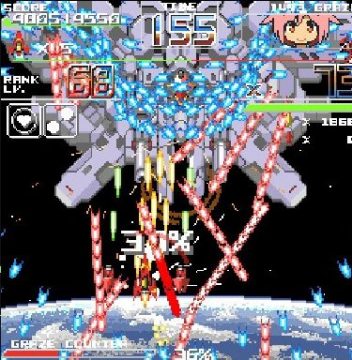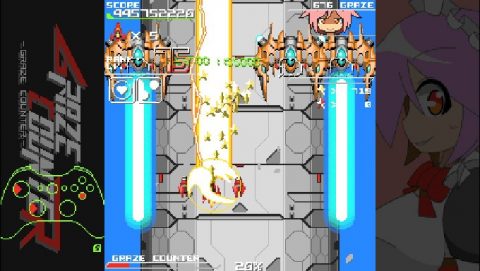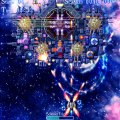NOTE: This review is primarily based on Graze Counter GM, released in January 2023. Comparisons between the remake and the original, non-GM version are located further down the text.
In the not-too-distant future, the virtual reality supercomputer network EDEN was created as an utopia free of worry or care for any citizen of the world to enjoy as they pleased, its many servers open for login and logout at any time of the day, any day of the week, anywhere in the world. But one day, something happens in the network’s main server, admin access to it is blocked, and all of a sudden, 2.4 million (or a hundred million in GM) users find themselves trapped in EDEN, unable to log out – or perhaps unwilling to. To rescue them and destroy whoever or whatever is causing this “glitch” and possible revolution, the covert special task force Saviours develops a pair of Attack Programs (represented in the VR world as highly capable fighter jets) codenamed April Divider and Freedom Dancer, puts experienced and gender-troubled agents Uzuki Ginyose and Satsuki Furuyama in control of them, and sends them to depths of the super-network – thus setting the stage for Graze Counter and its remake Graze Counter GM, developed by doujin group Bikkuri Software and published in the West by Henteko Doujin and Sanuk Inc..
Mechanically, Graze Counter resembles a cross between Cave’s later Dodonpachi games and Psyvariar, with an unique gameplay flow that resembles that of the acclaimed doujin shoot-em-up Crimzon Clover in how it challenges the player to balance offense, defense and scoring without being too punitive about it. There is no bomb stock to be spent here – instead there is a gauge on the bottom-left corner of the screen filled by grazing enemies and their bullets. When it is at least 50% full, tapping the second action button unleashes the titular Graze Counter, a full-screen-tall laser beam that cancels all bullets (even lasers), deals big damage and releases small stars on contact with enemies big or small. These stars not only add up to your score, but also fill the Break gauge on the bottom-right of the screen – once full, a tap of the third action button engages Break mode, wiping all onscreen bullets upon activation and massively empowering the player ship’s shots for a while (even more so than the Graze Counter). You can still trigger your Graze Counter while on Break mode, but doing so will immediately end your Break. The fourth action button is reserved to slowing down the player ship.
Unlike in most bullet hell shoot-em-ups, where bombs are scarce and valuable to the point of becoming a secondary aspect of gameplay despite having a whole button dedicated to them, your Graze Counter in Graze Counter is almost always ready to be deployed, since enemy bullets are plentiful and the hitbox on the player ships quite generous. But don’t go thinking that this means the game allows players to be reckless with their bombing: a well-timed Counter can be the difference between life and death, and survival depends on maintaining a constant and efficient Counter-Break-Counter-Break cycle fueled by grazing through showers of bullets even while on Break mode. This risk-reward tug-of-war is also integral to the game’s scoring, which revolves around a multiplier that can be increased up to 1000x by – you guessed it – grazing through enemy bullets and which decays rapidly when the player isn’t risking their precious lives. Staying in Break mode slows down that decay considerably for a good while.
What sets Graze Counter apart from other shoot-em-ups with similar gameplay structures – like the aforementioned Crimzon Clover – is the amount of flexibility and game customizability it offers the player. There are six difficulty levels to choose between at the start of each run (eight in the GM remake), two ships to choose from (with more unlocking as you play through the game, up to a whopping 16 in GM) and, most uniquely, a bunch of character-specific tweaks to the game mechanics to choose from. As you can’t begin a run without choosing any of these Skill Cards, they’re less about fundamentally changing the way you play the game and more about allowing players of all skill levels and play styles to enjoy the bullet hell fun. If you do want to be made to play differently, however, you can always turn on Pacifist Mode at the beginning of your run, which deactivates all of your offensive options – thus forcing you to rely only on your bullet-dodging skills for survival.
Graze Counter‘s main game mode is five stages long, with stages 2 and 4 allowing the player to choose between two completely different scenarios each. Stage 3’s boss fight pits the player against their chosen pilot’s rival, and Stage 5 sees them and the rest of the main cast help you out in your charge against the two final bosses, with a short reprise of the first stage’s midboss and endboss preceding the final showdowns. The meat of the game is in replaying these five stages again and again to experiment with different combinations of ships, traits and difficulty settings until you find the one that best goes with your skill level and play style, then challenging yourself by switching up your choices and trying to play differently than you usually do. It’s a short but meaty game, with Mission and Boss Rush modes offering even shorter playtimes than the standard mode, and All Stage Mode, an insanely difficult extra stage and a fun little minigame being unlocked once you beat the main campaign (with all characters, in the case of the minigame).
Visually, Graze Counter takes after your usual gaggle of 90s STGs, with bright colorful bullets and beams seemingly pulled straight out of Cave’s games and chunky, almost candy-like enemies that just scream Toaplan and RayForce. The score in particular uses a font similar if not identical to the one used on the HUDs of the 16 and 32-bit Gradius games, making it hard to read at first – especially when 4s and 9s are involved. The original 2017 release’s HUD, located at the top of the game screen, can be a nuisance at times due to its unusually player-friendly, informative nature, a problem which the 2023 remake thankfully avoids by taking after M2’s ShotTriggers releases and moving all game-relevant information to the previously-empty borders of the screen. The soundtrack is catchy, well-made and fairly memorable, but the game ships with terrible audio mixing, with excessively loud, constantly-clipping sound effects – which is a shame, since the developers have put extra care in making sure things like losing a shield, topping up your gauges and triggering Break mode all have unique, noticeable audio tells (sadly to the detriment of valuable visual cues).
Graze Counter was originally released for PCs in 2017, with a remake, Graze Counter GM, landing on all major platforms in the beginning of 2023 – the GM in the title standing for Game Maker, the engine to which the game was ported to in this new release. Graze Counter GM is a major revamp of the original, a true remake: everything in the game was rebuilt from the ground up to look, sound and feel more modern and professional, and a slew of new features have been added to appeal to both casual and hardcore players. The difficulty settings have been tweaked, the character selection and storyline expanded, the soundtrack rearranged, the graphics redrawn, and all stages redesigned. The level and boss design alterations in particular change the moment-to-moment gameplay and difficulty balance quite a bit, to the point that the two versions of the game feel like distinct takes on the same basic design plan – like different revisions and/or regional releases of the same 80s or early-90s arcade game. Unlike in many such cases, however, both versions of Graze Counter are worth playing, with the original version in particular having plenty of that crusty old-school doujinsoft charm that GM and modern indie games in general lack.



